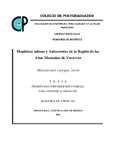| dc.contributor.author | Campos Cerón, Monserrath | |
| dc.creator | CAMPOS CERÓN, MONSERRATH; 557805 | |
| dc.date.accessioned | 2019-07-22T14:41:26Z | |
| dc.date.available | 2019-07-22T14:41:26Z | |
| dc.date.issued | 2016-06 | |
| dc.identifier.uri | http://hdl.handle.net/10521/3591 | |
| dc.description | Tesis (Maestría en Ciencias, especialista en Botánica).- Colegio de Postgraduados, 2016. | es_MX |
| dc.description.abstract | Las hepáticas talosas y antocerotes son plantas poco conocidas en términos florísticos y ecológicos. En su medio natural, diferentes actividades humanas constituyen una amenaza. Ante ambas observaciones, el objetivo fue estudiar la riqueza florística de hepáticas talosas y antocerotes de la región de las Altas Montañas de Veracruz (RAMV). Suponemos que la riqueza de hepáticas talosas y antocerotes es diferente entre pisos altitudinales y tipos de vegetación en la RAMV. El material botánico se recolectó en dos recorridos mensuales efectuados de junio 2014 a febrero 2015, en siete localidades de siete municipios de la RAMV. Se colectaron ejemplares de junio 2014 a febrero 2015, para la identificación de las especies. Se cuantificó abundancia y cobertura con la escala Braun-Blanquet modificada. Se analizó la semejanza florística entre localidades y unidades de muestreo con los índices de Jaccard y Sorensen-Dice. Se aplicó un análisis de correspondencia. Se identificaron 22 especies, cinco nuevos registros de hepáticas talosas y seis especies de antocerotes para la región de las Altas Montañas de Veracruz. La riqueza de estas briofitas difiere entre Bosques Tropicales. Los antocerotes mostraron mayor distribución a lo referido. Hubo semejanza entre localidades. El análisis de correspondencia reveló afinidad a un gradiente de humedad. Las hepáticas talosas prosperaron mejor en el Bosque Tropical Montano Inferior (Bosque Húmedo de Montaña) y los antocerotes en el Bosque Tropical Submontano (Selva Mediana). La humedad influye en la cobertura y el establecimiento de las especies. Se advierte riesgo en la persistencia de hepáticas talosas y antocerotes por la pérdida de vegetación autóctona. _______________ THALLOID LIVERWORTS AND HORNWORTS OF THE REGION OF THE HIGH MOUNTAINS OF VERACRUZ. ABSTRACT: Thalloid liverworts and hornworts are little known in ecological and floristic plants. In their natural environment, various human activities pose a threat. Before both observations, the objective was to study the floristic richness of thalloid liverworts and hornworts in the region of the high mountains of Veracruz (RAMV). It is assumed that the richness of thalloid liverworts and hornworts is different into altitudinal levels and vegetation kinds in RAMV. Specimens for species identification were collected from June 2014 to February 2015. Abundance and coverage were quantified with the modified Braun-Blanquet scale. Floristic similarity between localities and sampling units were analyzed with Jaccard and Sorensen-Dice. Correspondence analysis was applied. 22 species were identified, five new records thalloid liverworts and six species of hornworts for the RAMV. The richness of these bryophytes differs between tropical forests. The hornworts distribution showed greater distribution as previous reports. There was similarity between localities. Correspondence analysis revealed affinity to a moisture gradient. The thalloid liverworts thrived best in the Tropical Lower Montane Forest (Rainforest Mountain) and hornworts in the Tropical Submontane Forest (Selva Medium). Moisture influences the coverage and establishment of species. Risk is seen in the persistence of thalloid liverworts and hornworts for the loss of native vegetation. | es_MX |
| dc.description.sponsorship | Consejo Nacional de Ciencia y Tecnología (CONACyT). | es_MX |
| dc.format | pdf | es_MX |
| dc.language.iso | spa | es_MX |
| dc.rights.uri | http://creativecommons.org/licenses/by-nc-nd/4.0 | es_MX |
| dc.subject | Anthocerotophyta | es_MX |
| dc.subject | Marchantiophyta | es_MX |
| dc.subject | Notothylas | es_MX |
| dc.subject | Nuevos registros | es_MX |
| dc.subject | Similitud florística | es_MX |
| dc.subject | Floristic similarity | es_MX |
| dc.subject | New records | es_MX |
| dc.subject | Botánica | es_MX |
| dc.subject | Maestría | es_MX |
| dc.subject.classification | BIOLOGÍA Y QUÍMICA::CIENCIAS DE LA VIDA::BIOLOGÍA VEGETAL (BOTÁNICA)::PRODUCCIÓN DE CULTIVOS | es_MX |
| dc.title | Hepáticas talosas y antocerotes de la región de las altas montañas de Veracruz. | es_MX |
| dc.type | Tesis | es_MX |
| Tesis.contributor.advisor | García Moya, Edmundo | |
| Tesis.contributor.advisor | Juárez Martínez, Catalina | |
| Tesis.contributor.advisor | Romero Manzanares, Angélica | |
| Tesis.contributor.advisor | Luna Cavazos, Mario | |
| Tesis.date.submitted | 2016-06 | |
| Tesis.date.accesioned | 2017 | |
| Tesis.date.available | 2017 | |
| Tesis.type | Tesis | es_MX |
| Tesis.format.mimetype | pdf | es_MX |
| Tesis.format.extent | 1,919 KB | es_MX |
| Tesis.subject.nal | Taxonomía vegetal | es_MX |
| Tesis.subject.nal | Plant taxonomy | es_MX |
| Tesis.subject.nal | Bosques tropicales | es_MX |
| Tesis.subject.nal | Tropical forests | es_MX |
| Tesis.subject.nal | Bryophyta | es_MX |
| Tesis.subject.nal | Hepáticas y musgos | es_MX |
| Tesis.subject.nal | Mosses and liverworts | es_MX |
| Tesis.subject.nal | Microhábitats | es_MX |
| Tesis.subject.nal | Microhabitats | es_MX |
| Tesis.subject.nal | Veracruz, México | es_MX |
| Tesis.rights | Acceso abierto | es_MX |
| Articulos.subject.classification | Ecología montañosa | es_MX |
| dc.type.conacyt | masterThesis | es_MX |
| dc.identificator | 2||24||2417||310301 | es_MX |
| dc.contributor.director | GARCÍA MOYA, EDMUNDO; 2255 | |
| dc.audience | generalPublic | es_MX |


